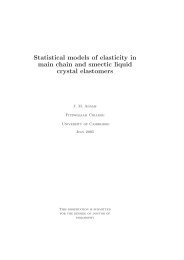Sandra Hopkins Final Report.pdf - University of Surrey
Sandra Hopkins Final Report.pdf - University of Surrey
Sandra Hopkins Final Report.pdf - University of Surrey
Create successful ePaper yourself
Turn your PDF publications into a flip-book with our unique Google optimized e-Paper software.
<strong>of</strong> 29% 42 . Image quality assessment by cardiologists considered there to be insignificant detrimentto image quality in the procedure being investigated.Measured patient doses for Acquisition using 19cm Perspex using standard clinical settings for thenew cath lab were found to be 126% higher for the 25cm field and 67% higher for the 20cm field(which is the field size typically employed for acquisition) when compared to the older cath lab.Part <strong>of</strong> the reason for this increase in dose is due to the higher specification detector doses describedearlier. Additionally it can be seen that there is no copper pre-filtration employed in the new roomwhereas 0.2mm <strong>of</strong> copper has been inserted in the old room. Manufacturers have made the decisionto remove the copper filtration in order to improve image quality and prolong tube life. This wouldresult in a significant increase in dose. However, it can be seen from the exposure factors that thekilovoltage has been increased and the mA reduced in an effort to reduce the patient dose. Theseadjustments, however, do not completely compensate for the increase in dose due to the removal <strong>of</strong>copper pre-filtration.Since users were happy with their old lab where pre-filtration was employed it would seemappropriate to re-programme the new room to have pre-filtration and exposure factors more in linewith the old room.Current Local DAP values are just above the Diagnostic Reference Level. A previous surveycarried out by the National Radiological Protection board 25 recommended a reference level forCardiac Angiography procedures <strong>of</strong> 36Gy.cm 2 . Current local values would have been below thisvalue. This demonstrates the fact that nationally, doses for Cardiac angiography are generallyreducing. Data collected in a study from 15 years ago 43 determined a mean DAP <strong>of</strong> 67Gy.cm 2 and a3 rd quartile value <strong>of</strong> 69Gy.cm 2 . Overweight or very thin patients were excluded from the study in asimilar manner to the current study so that they did not skew the data. However, this mean value isconsiderably higher than that obtained in the current study. This is partly attributable to the fact thatolder fluoroscopy systems would generally operate at a higher dose and also that the data comesfrom examinations performed in other countries where the standard technique may be verydifferent. A larger and more recent study included England in the data analysis and this providedDAP values more in line with what is currently achieved locally 27 . A study on two different systemsin the UK in 1997 44 gave mean DAP values for Cardiac Angiography <strong>of</strong> 47.7Gy.cm 2 and 23.4Gy.cm 2 . The difference in DAP can be explained by the fact that one room has a biplane imageintensifier system which will give greater imaging capability but will also increase the dose. Thisstudy did not remove large or small patients. Instead size correction factors were used that had beenobtained in a previous study 45 .38
















